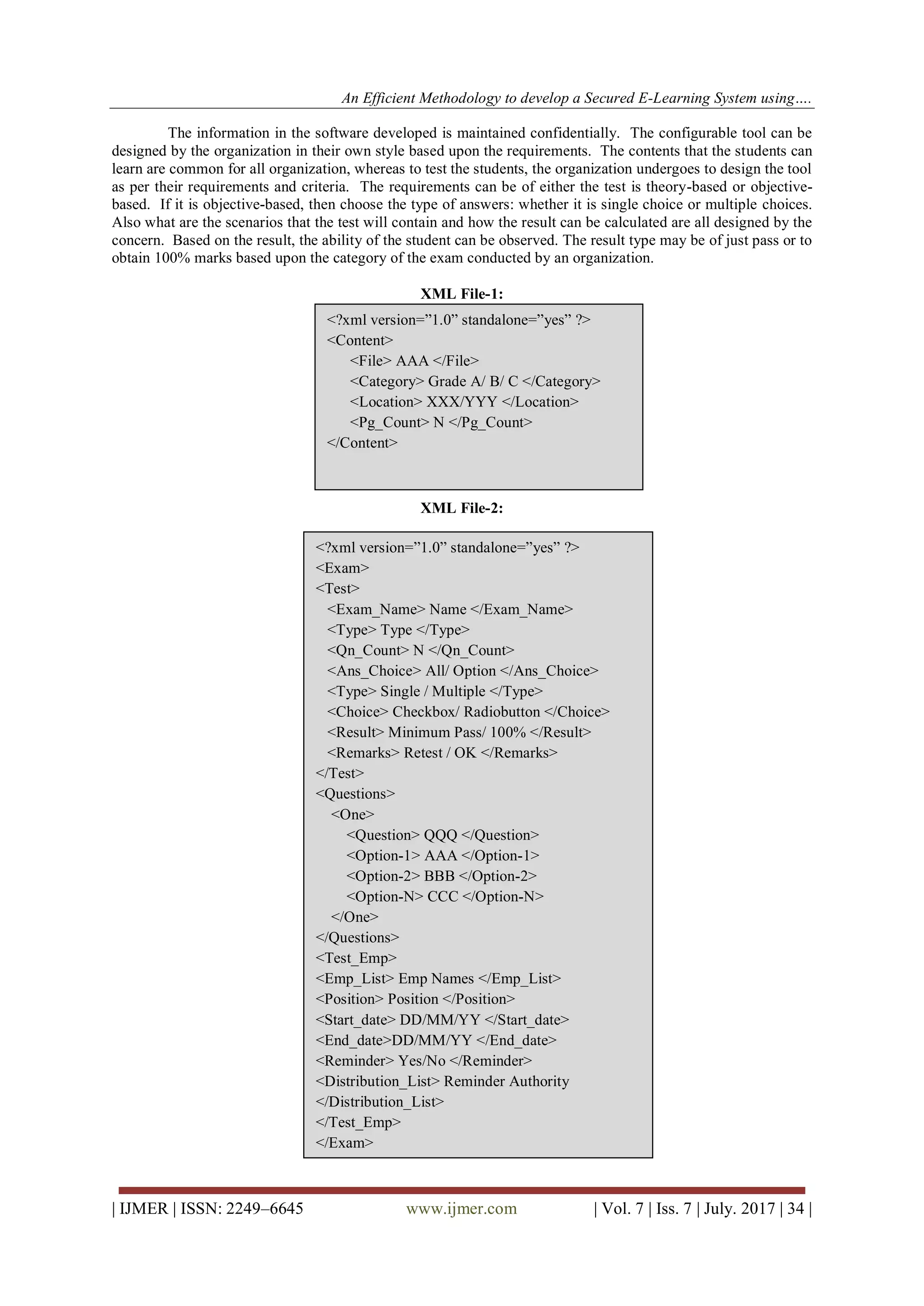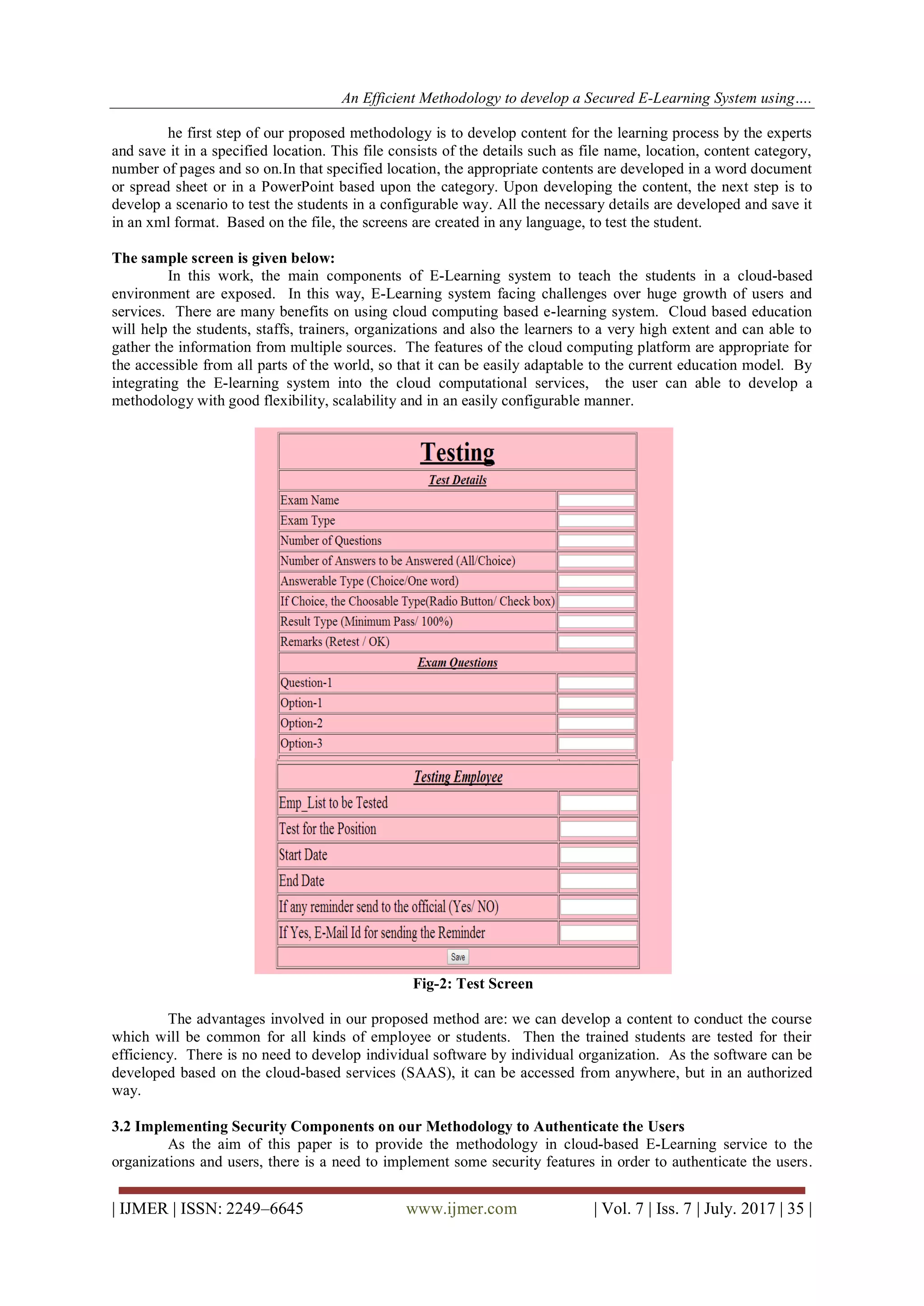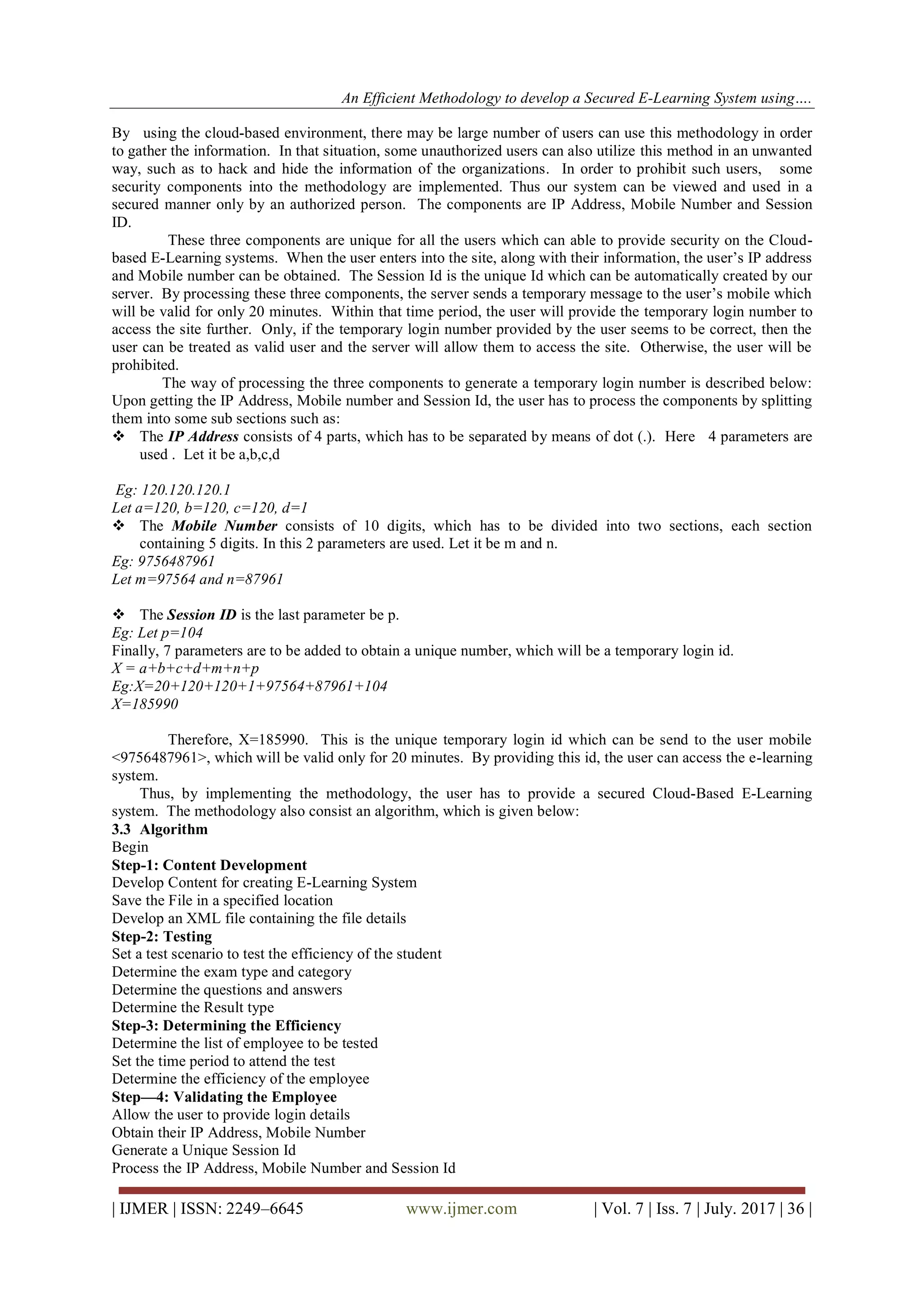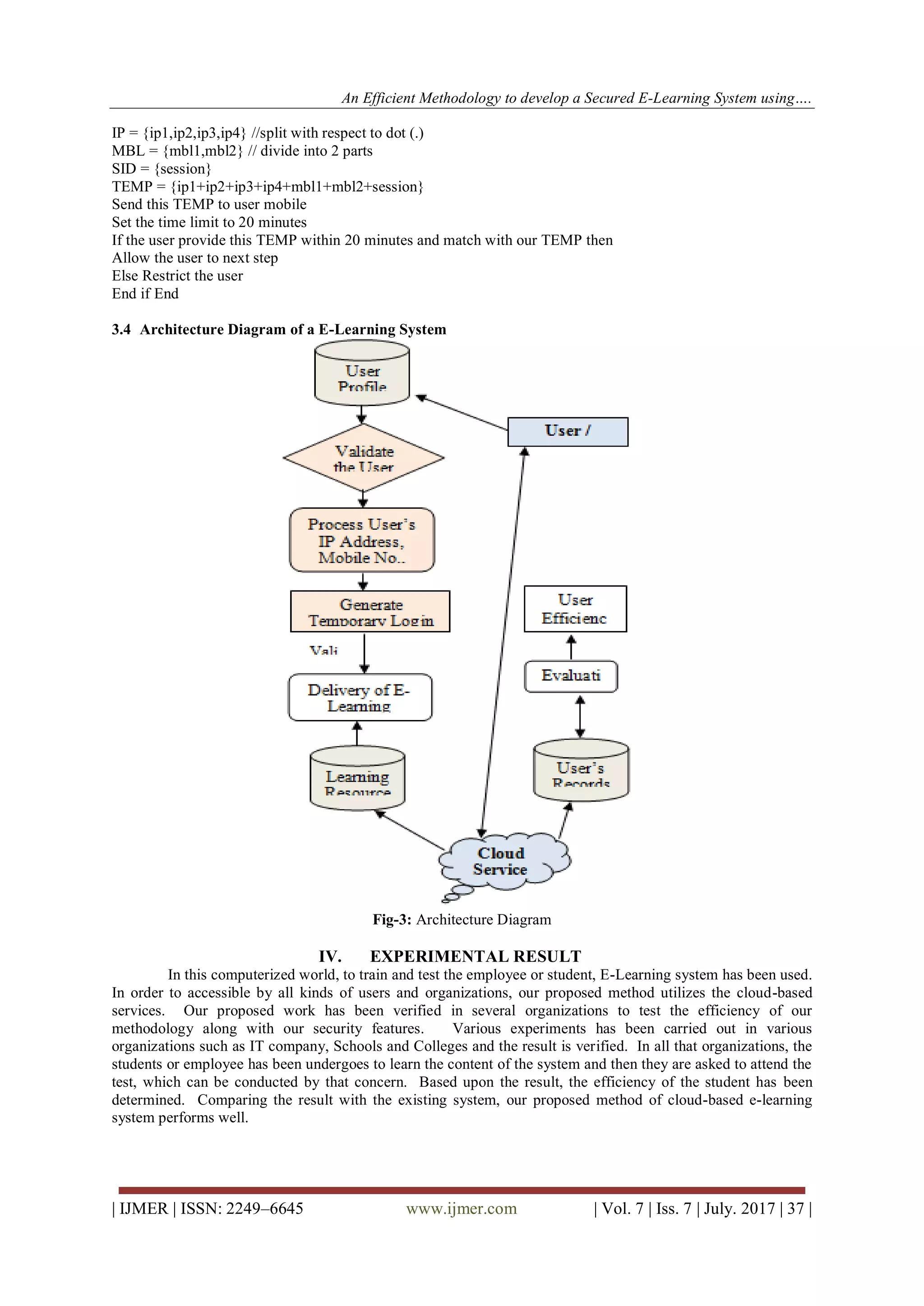This document discusses the development of a secured e-learning system utilizing cloud computing technologies to enhance educational processes. It outlines the methodology for implementing this system, focusing on the benefits of cloud services, security measures, and customizable tools for educational institutions. The proposed system aims to improve efficiency and accessibility in education while maintaining data security for users.
![International
OPEN ACCESS Journal
Of Modern Engineering Research (IJMER)
| IJMER | ISSN: 2249–6645 www.ijmer.com | Vol. 7 | Iss. 7 | July. 2017 | 31 |
An Efficient Methodology To Develop A Secured E-Learning
System Using Cloud Computing Services
S. Arulselvarani1
, c.lalitha2
,
S.T.E.T Women’s College, C.S. Dept., Mannargudi, India
C.T.T.E College For Women, Chennai .
I. INTRODUCTION
In this new century, our society has been transformed or reshaped with advanced technologies in most
fields such as education, telecommunication, sciences and so on. This is because to improve the business
strategy and to meet all the requirements easily and efficiently. Education is one of the important components in
our life. E-Learning is defined as an Internet-enabled Learning in which the student can able to learn himself or
herself. With Information Technologies (IT), there is an emerging trend regarding the research and exploitation
of E-Learning systems. This sometimes related to virtual distance education, which may support the teaching-
learning process, through E-Mail, web pages etc. Now-a-days, Cloud Computing plays a vital role along with
E-Learning. These two technologies rising speedily and plays a powerful role in the field of education, learning
and training. It provides virtual environment to the students which will help them to learn easily.
The Cloud Computing is a collection of services or resources that can be accessed remotely via the
Internet. Using this, the software developers can able to create, store and access the information by much more
efficient way, in order to increase the access to communicate and also to decrease the cost. Most organizations
such as educational institutes, businesses and other industries are very excited to adopt this cloud computing
services for cost saving, scalability, ease of use, time shifting, fault tolerance, broad access, and security and
maintenance.
Thus, in our research work, cloud-based services (SAAS) are utilized in order to implement the methodology.
The algorithm in this paper, performs well to demonstrate how the software can be useful for different
kinds of users of different concern and the performance evaluation also be given in the experimental results
section.
II. RELATED WORK
Paul et al, in paper [1] described that Cloud computing is growing rapidly, with applications in almost
any area, including education. E-learning systems usually require many hardware and software resources. There
are many educational institutions that cannot afford such investments, and cloud computing is the best solution.
The paper presented the positive impact of using cloud computing architectures upon e-learning solutions
development. It focuses on the benefits of cloud computing for e-learning solutions and the e-learning project
management challenges when this architecture is used. Sudhir et al, in paper [2] stated that the gaining
popularity of erudition on the internet, the edifice of perfect web-based learning environment has become one of
the hottest points on researching remote education. Cloud Computing and E-Learning plays a vital role and it
supports the smart phone mobile users to perform their tasks effectively with paying less cost by utilizing the
cloud-based applications offered by the cloud service providers. These technologies are aimed at running
ABSTRACT: Now-a-days, each and every action involved in our life becomes computerized in order
to reduce the time, complexity and manual power. The education systems are also being computerized,
to train the students in a much efficient way. This system is termed as E-Learning. E-Learning is an
Internet-based learning process, in which the Internet technology is used to design, implement, manage
and extend learning, which will improve the efficiency of learning. Learning, Teaching and Training
are intensely connected components, which are all included in the development of E-Learning system.
Cloud Computing provides an efficient platform to support the E-Learning systems, as it can be
dramatically changes over time .In this paper, an overview on the new emerging E-Learning system ,
utilization of the SAAS (Software as a Service) and the methodology to test the efficiency of the person
in a secured way are described.
Keywords: Cloud Computing, E-Learning, Internet-based learning, Learning, SAAS, Teaching,
Training.](https://image.slidesharecdn.com/e7713139-170718082726/75/An-Efficient-Methodology-To-Develop-A-Secured-E-Learning-System-Using-Cloud-Computing-Services-1-2048.jpg)
![An Efficient Methodology to develop a Secured E-Learning System using….
| IJMER | ISSN: 2249–6645 www.ijmer.com | Vol. 7 | Iss. 7 | July. 2017 | 32 |
applications such as word processing, spreadsheets, access database and many more provided by the internet
service provider in the virtual environment while on the move by a flexible infrastructure as all the data and
information is stowed in the cloud ambiance. The paper focused on how e-learning benefits the e-learners by
using cloud computing services and presents e-learning approaches by using cloud computing.
Fernandaz et al, in paper [3] stated in this contribution, they gave an overview of the current state of the
structure of Cloud Computing for applications on e-learning. They provided details of the most common
infrastructures that have been developed for such a system, and finally they presented some examples of e-
learning approaches for Cloud Computing that can be found in the specialized literature Deepan shu et al, in
paper [4], stated in the paper that the use of cloud computing in the educational and learning arena, to be called
‟Education and Learning as a Service” (ELaaS), emphasizing its possible benefits and offerings. It is essential
for an educational and learning organization, with its budget restrictions and sustainability challenges, to use the
cloud formation best suited for a particular IT activity. In the paper, web-based learning environment and the
concept of cloud computing are discussed. The latest development of cloud computing.
Nair et al, in paper [5], discussed that the popularity of learning on the internet, the construction of
perfect web based learning environment has become one of the hot points on researching remote education. It is
envisioned that, in the near future, cloud computing will have a significant impact on the educational and
learning environment, enabling their own users(i.e., learners, instructors, and administrators) to perform their
tasks effectively with less cost by utilizing the available cloud-based applications offered by the cloud service
providers. Therefore, there is a need to redesign the educational system to meet the needs better. . E-learning
systems usually require many hardware and software resources. There are many educational institutions that
cannot afford such investments, and cloud computing is the best solution. They presented several case studies
for educational clouds introduced by popular cloud providers which reflect the increasing interest in this new
trend. They also discussed future challenges to cloud education. Robert Goodwin et al, in paper [6], stated that
developments in computing are influencing many aspects of education. The purpose of the paper is to assess the
potential value of cloud computing as a platform for e-learning. In particular, the paper will discuss how cloud
computing is different from other forms of computing and what makes it unique. As well is this, the potential
advantages and disadvantages of using cloud computing as a platform for e-learning will be outlined. Finally,
the requirements of implementing cloud computing will be discussed, along with an assessment of the
challenges to implementation, and some potential ways to overcome them.
Abu et al, in paper [7], presented a creative environment derived from both virtual and personal
learning environments based on cloud computing which contains variety of tools and techniques to enhance the
educational process. The proposed environment focuses on designing and monitoring educational environment
based on reusing the existing web tools, techniques, and services to provide Browser-based-
Application.Radhakrishnan et al, in paper [8], discussed that the popularity of learning on the internet, the
creation of perfect web-based learning environment has become one of the hot points on researching remote
education. It is predicted that, in the near future, cloud computing will have a significant impact on the
educational and learning environment, facilitating their own users(i.e., learners, instructors, and administrators)
to perform their tasks effectively with less cost by utilizing the available cloud-based applications offered by the
cloud service providers. The paper discussed the employability of cloud computing in the educational and
learning ring, to be called “Teaching and Learning as a Service” (TLaaS), emphasizing its possible benefits and
offerings.Alberto Fernandez et al, in paper [9], gave an overview of the current state of the structure of cloud
computing, and we provide details of the most common infrastructures that have been developed for such a
system. They also presented some examples of e-learning approaches for cloud computing, and finally, they
discussed the suitability of this environment for educational data mining, suggesting the migration of this
approach to this computational scenario.
Anwar et al, in paper [10] stated that the e-learning cannot entirely replace educators; it is merely an
updating for technology, concepts, tools and ideas that gives new content in the field of education. The
educators and students are playing prominent roles and contribute in developing and making use of e-learning
cloud. This unified learning approach is improving the educational act. E-learning cloud is a new journey of
cloud computing technology in the field of e-learning, which is a future e-learning infrastructure that includes all
the needed hardware and software computing resources engaging in E-learning.
Zuev, in paper [11] stated that the article looks into methods and models that are useful when analyzing
the risksand vulnerabilities of complex e-learning systems in an emergency management context. Definitions of
vulnerability and emergency response capabilities, such as “VLE/PLE attack surface”, are suggested. The
article provided insight into some of the issues related to analysis of risks and vulnerabilities of e-learning
systems George Yee, in paper [12] examined privacy and security issues associated with e-learning. It presents
the basic principles behind privacy practices and legislation. It investigates the more popular e-learning
standards to determine their provisions and limitations for privacy and security. Privacy requirements for e-
learning systems are explored with respect to the “Privacy Principles”. The capabilities of a number of existing](https://image.slidesharecdn.com/e7713139-170718082726/75/An-Efficient-Methodology-To-Develop-A-Secured-E-Learning-System-Using-Cloud-Computing-Services-2-2048.jpg)
![An Efficient Methodology to develop a Secured E-Learning System using….
| IJMER | ISSN: 2249–6645 www.ijmer.com | Vol. 7 | Iss. 7 | July. 2017 | 33 |
privacy enhancing technologies, include methods for network privacy, policy-based privacy security
management, and trust systems.
Sunil et al, in paper [13] stated that, apart from integrity enforcement, security enforcement in the
whole system is the other crucial way to organize it. As internet is the backbone of the entire system which is
inherently insecure, during transaction of message in E-Learning system, hackers attack by utilizing different
loopholes of technology. So, different security measures are required to be imposed on the system. In the paper,
emphasis is given on different risks called e-risks and their remedies called e-remedies to build trust in the
minds of all participants of E-Learning system..
III. PROPOSED METHODOLOGY
3.1 Proposed Method
The aim of this paper is to propose a methodology for implementing a cloud-based Learning system in
a secured manner. E-Learning is broadly used in different educational institutions to train and test the efficiency
of the students. In this research work, methodology is proposed to satisfy the aim of the paper. The
description of the proposed method is given below:
Fig-1: Cloud-Based E-Learning System
E-Learning is mainly used in schools, colleges and companies in order to train the students. This has to
be carried out by developing software which contains all the educational contents in detail and in an easier way.
The software must be of generalized as well as customized one, such that it can be utilized by all kinds of
organizations and by all kinds of people. Through this, the individual development cost and testing cost for an
organization will be reduced. Thus, development is required for a customized tool with cloud-based
environment. By using this tool, each organization can able to configure according to their requirements.
In the methodology, the software developer develops a methodology by placing all the necessary
contents and configurable tools into the E-Learning Server, which will come under the cloud environment. The
configurable tool is the scenario and criteria that can be modified by an organization based upon their
requirements. The E-Learning clients can only be communicable with the Cloud services, which in turn, can
switch the user to the appropriate server based upon their criteria. Thus, the cloud-based E-Learning system can
able to train the students in a much better way.](https://image.slidesharecdn.com/e7713139-170718082726/75/An-Efficient-Methodology-To-Develop-A-Secured-E-Learning-System-Using-Cloud-Computing-Services-3-2048.jpg)




![An Efficient Methodology to develop a Secured E-Learning System using….
| IJMER | ISSN: 2249–6645 www.ijmer.com | Vol. 7 | Iss. 7 | July. 2017 | 38 |
Fig-4: Comparison Chart
V. CONCLUSIONS
In this work, the main components of E-Learning system to teach the students in a cloud-based
environment along with security features were exposed. In order to avoid unwanted access from unauthorized
users, the system with security enhancement was implemented. In this way, E-Learning system facing
challenges over huge growth of users and services. There are many benefits on using cloud computing based e-
learning system. Cloud based education will help the students, staffs, trainers, organizations and also the
learners to a very high extent and can able to gather the information from multiple sources in a secured manner.
The features of the cloud computing platform are appropriate for the accessible from all parts of the world, so
that it can be easily adaptable to the current education model. By integrating the e-learning system into the
cloud computational services, the user can able to develop a methodology with good flexibility, scalability
securable and in an easily configurable manner.
REFERENCES
[1]. Paul Pocatilu, Felician Alecu, Marius Vetrici, “Using Cloud Computing for E-Learning Systems”, Recent
Advances on Data Networks, Communications, computers, ISSN: 1790-5190
[2]. Sudhir Kumar Sharma, Nidhi Goyal, Monisha Singh, “Distance Education Technologies: Using E-Learning
System and Cloud Computing”, International Journal of Computer Science and Information Technologies, Vol.5
(2), 2014.
[3]. A. Fernandez, D. Peralta, F. Herrera, and J.M. Benitez, “An Overview of E-Learning in Cloud Computing”,
Workshop on LTEC 2012, Springer pp.35-46.
[4]. Deepanshu Madan, Ashish Pant, Suneet Kumar, Arjun Arora, “E-Learning based on Cloud Computing”,
International Journal of Advanced Research in Computer Science and Software Engineering, Vol 2, Issue 2, Feb
2012.
[5]. Bhruthari G. Pund, Sanil S. Nair, and Prajakta P Deshmukh, “Using Cloud Computing on E-Learning”,
International Journal of Emerging Trends & Technology in Computer Science (IJETTCS), Vol 1, Issue 2, July-
Aug 2012.
[6]. Faten Karim, Dr. Robert Goodwin, “Using Cloud Computing in E-Learning Systems”, International Journal of
Advanced Research in Computer Science and Technology (IJARCST), Vol 1, Issue 1, Oct-Dec 2013.
[7]. N. S. Abu El-Ala, W. A. Awad, “Cloud Computing for Solving E-Learning Problems”, International Journal of
Advanced Computer Science and Applications (IJACSA), Vol 3, 2012.
[8]. Radhakrishnan. N, Chelvan, N.P. , Ramkumar. D, “Utilization of Cloud Computing in E-Learning Systems”,
Cloud Computing Technologies, Applications and Management (ICCCTAM), Dec 2012.](https://image.slidesharecdn.com/e7713139-170718082726/75/An-Efficient-Methodology-To-Develop-A-Secured-E-Learning-System-Using-Cloud-Computing-Services-8-2048.jpg)
![An Efficient Methodology to develop a Secured E-Learning System using….
| IJMER | ISSN: 2249–6645 www.ijmer.com | Vol. 7 | Iss. 7 | July. 2017 | 39 |
[9]. Alberto Fernandez, Daniel Peralta, Jose Manuel Benitez and Francisco Herrera, “E-Learning and educational data
mining in cloud computing: an overview”, Internation Journal on Learning Technology, Vol 9, 2014.
[10]. Masud Md. Anwar Hossain, Huang Xiaodi, “An E-learning System Architecture based on Cloud Computing”,
World Academy of Science, Engineering and Technology 62 2012.
[11]. Vladimir I. Zuev, “E-Learning Security Models”, Management Informaion Systems, Vol. 7, Apr 2012.
[12]. Khalil El-Khatib, Larry Korba, Yuefei Xu and George Yee, “Privacy and Security in E-Learning”, International
Journal of Distance Education, Vol. 1, Oct-Dec 2003.
[13]. Nikhilesh Barik and Dr. Sunil Karforma, “Risks and Remedies in E-Learning System”, International Journal of
Network Security & its Applications(IJNSA), Vol. 4, Jan 2012.](https://image.slidesharecdn.com/e7713139-170718082726/75/An-Efficient-Methodology-To-Develop-A-Secured-E-Learning-System-Using-Cloud-Computing-Services-9-2048.jpg)